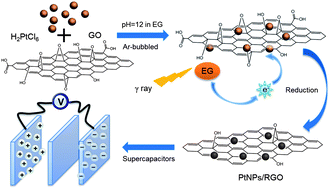A facile synthesis of platinum nanoparticle decorated graphene by one-step γ-ray induced reduction for high rate supercapacitors†
Abstract
A facile method has been developed to synthesize a high-quality

* Corresponding authors
a
Beijing National Laboratory for Molecular Sciences, Department of Applied Chemistry and the Key Laboratory of Polymer Chemistry and Physics of the Ministry of Education, College of Chemistry and Molecular Engineering, Peking University, Beijing 100871, China
E-mail:
mlzhai@pku.edu.cn
Fax: +86-10-62753794
b College of Chemical and Environmental Engineering, China University of Mining and Technology, Beijing 100083, China
c State Key Laboratory of Organic–Inorganic Composites, Department of Polymer Engineering, College of Materials Science and Engineering, Beijing University of Chemical Technology, Beijing 100029, China
A facile method has been developed to synthesize a high-quality

 Please wait while we load your content...
Something went wrong. Try again?
Please wait while we load your content...
Something went wrong. Try again?
Q. Zhang, Y. Zhang, Z. Gao, H. Ma, S. Wang, J. Peng, J. Li and M. Zhai, J. Mater. Chem. C, 2013, 1, 321 DOI: 10.1039/C2TC00078D
To request permission to reproduce material from this article, please go to the Copyright Clearance Center request page.
If you are an author contributing to an RSC publication, you do not need to request permission provided correct acknowledgement is given.
If you are the author of this article, you do not need to request permission to reproduce figures and diagrams provided correct acknowledgement is given. If you want to reproduce the whole article in a third-party publication (excluding your thesis/dissertation for which permission is not required) please go to the Copyright Clearance Center request page.
Read more about how to correctly acknowledge RSC content.
 Fetching data from CrossRef.
Fetching data from CrossRef.
This may take some time to load.
Loading related content
